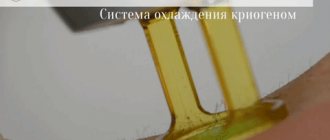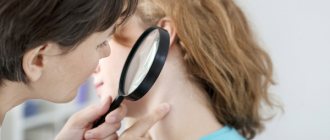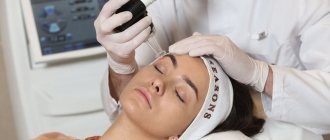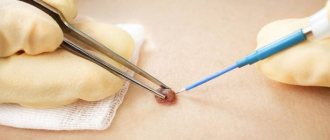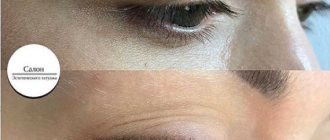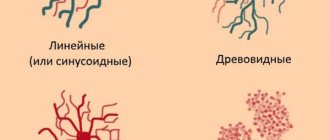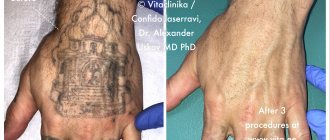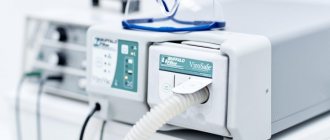Pigment spots on the face are the most unpleasant. They cannot be covered with clothing or hair. Our interlocutors look at our face. Photos and videos save stains forever. And an unsuccessful attempt to get rid of pigmentation on the face will have especially terrible consequences.
And although the use of laser in cosmetology no longer raises questions - we have heard a lot about hair removal and rejuvenation using laser technologies, laser removal of pigment spots still remains a “blind spot” for many people.
What is skin hyperpigmentation: understanding the anatomy
Age spots are accumulations of melanin pigment in our skin. This pigment is created by our body to protect our body from negative external influences, most often from ultraviolet radiation contained in sunlight. The brown pigment serves as an “umbrella”, preventing UV radiation from penetrating deep into our internal organs. It is what creates a tan on our skin.
Exactly how much melanin needs to be synthesized is regulated by the hormonal system. But each person also has a genetically programmed pigment production program, which determines the color of our skin and the ability to tan.
If a hormonal imbalance occurs in the body, then the production of melanin may become excessive, it will be unevenly distributed throughout the thickness of the skin - this is how areas of hyperpigmentation or age spots are formed.
Increased formation of melanin can also be caused by injuries, skin damage due to aggressive procedures or mechanical stress (for example, when removing inflammatory elements), as well as taking certain medications or deficiencies of vitamins and microelements.
How to speed up pigment removal after laser removal
Strict adherence to the instructions of the attending physician helps to speed up the removal of pigment after laser removal.
Rules for patients to help eliminate the risk of complications:
- In the first 7-14 days after the procedure, avoid makeup;
- Use products with SPF protection;
- For the first two weeks, do not be exposed to sunlight, avoid peelings, scrubs and cosmetics containing alcohol;
- Use restorative and moisturizing products.
It is important to avoid thermal effects. Then the skin will be renewed and the irritating defect will completely disappear.
The principle of laser action on pigment spots
You may know how a laser “works” during hair removal - its radiation is literally “absorbed” by the hair shaft, causing it to instantly burn out and the hair follicle to die. The laser pulse in this case uses the pigment melanin, which is abundant in hair and follicle cells, as a target.
If a laser configured for hair removal is directed at the skin, the skin will get burned and a lighter spot may subsequently remain on it. The radiation from such a laser is too powerful and it is enough not only to heat and destroy melanin, but also to spread to surrounding cells, overheating them too.
But if you choose the right settings - the energy of the pulse, its duration and the frequency of emission of laser flashes, then you can transfer just enough energy to the skin so that it concentrates on the pigment, destroys it, without being transmitted to “healthy” cells and without damaging them.
How to make the procedure effective and safe
Experts practicing laser therapy do not always recommend the necessary preparation of the skin for 2 reasons:
- Immediately after the procedure there are no undesirable effects / not visible
- Fear of scaring off the client, who may not return a month after skin preparation
If you have a firm goal of getting lightening/getting rid of spots on your face, you need to carry out specialized skin preparation for 1 month.
Preparing the skin for laser therapy includes:
I. Use of brightening agents
Recommended scheme for using lightening agents*:
- Lightening serum "SkinBright" - suppresses the activity of excited melanocytes, use on the entire face 2 times a day.
- Retinol serum "Brighting" contains Retinol 2% and brightening complexes - use locally on spots.
- Antioxidant mask “C-Infusion” with Vitamin C - actively removes pigment and rejuvenates the skin.
- CBD Blue Light moisturizing cream with Cannabidiol and Blue Light filters with protection against radiation from electronic gadgets (evening)
Important! Do not use products containing hydroquinone , because it leads to the death of melanocytes and irreversible depigmentation, and therefore the use of this substance is currently prohibited in a number of countries.
II. Daily use of sunscreen
Mineral cream SPF 30 with zinc and protection against infrared and blue light. To exclude provocation of the production of melanocyte-stimulating hormone.
*all links to drugs are clickable, click for more detailed information.
What lasers remove pigmentation?
As is clear from the previous text, lasers that target melanin are suitable for removing hyperpigmentation. These are alexandrite lasers. But not every device of this type “can” work with pigmentation. It depends on the manufacturer whether he has included the necessary settings and modes in his equipment. After all, it is not enough to reduce the power and duration of the pulse; it is necessary to study and subsequently prove that such parameters will be safe and effective.
There are other lasers that can remove hyperpigmentation - erbium and carbon dioxide. But their effect is completely different - they simply evaporate microscopic areas of the skin, forcing the surrounding tissues to regenerate and renew themselves. Procedures using such lasers are a rather painful and traumatic process, with a high risk of negative complications, which, of course, is better to avoid when removing age spots on the face.
Removing age spots with PicoSure laser: personal experience
Julia went to remove age spots on her face using the new PicoSure laser. What successes have you achieved? Lots of before and after selfies. Probably everyone who has been reading this blog for any length of time knows that I have a pigment spot on my face and I am constantly trying to make it paler. Pigmentation on my cheekbone appeared when I was 15 years old (it seemed to be due to a hormonal imbalance at that time), but it was small and faint. But it gradually increased, and when I began to treat acne with drugs containing acids, the spot grew noticeably. When I was 27-28 years old, I first thought about how I needed to disguise it somehow - and I started covering it up with different concealers. Basically, to no avail - such pigment shines through both the tone and ordinary concealers, even the densest ones.
Later, makeup artists taught me that for an age spot you need a pink or salmon-colored concealer - it covers up the brown. This has improved my relationship with concealers—but not my dark spot. I tried to harass him with different lasers - elos, clear&brilliance, injected him with a special drug, smeared him with anti-pigmentation serums. Every day I manically applied a cream with an SPF of at least 30 (usually 50). But the situation worsened with the first rays of sunshine in March. Since living at the North Pole in some kind of eternal darkness and never going to the sea to the equator was not part of my plans, I gradually almost resigned myself to it. Well, there’s this particular feature of my face that you can’t do anything about. And yes, it changes - it becomes brighter in the summer, paler in the winter, it grows. As a result, I even stopped hiding the spot with makeup - you don’t disguise the presence of eyes or a nose, and that’s pretty much how I started to feel about the presence of brown spots on my cheek.
But the beauty industry never stands still! -) And my chances of leaving everything as it was were low. The new Evolution clinic, which opened in the spring on 1st Tverskaya-Yamskaya, has a new, world’s first picosecond laser, PicoSure. We did a lot of material about how it works - an interview with laser cosmetology expert Jeremy Brauer. Briefly: it appeared in 2013, was invented to remove tattoos (including colored ones) - and today it does this more effectively than all other lasers. At the same time, it turned out that it rejuvenates, removes pigmentation, and post-acne scars. Received FDA approval as the first of its kind. There is no thermal effect or ablation, and there is virtually no rehabilitation period. The laser works on the photomechanical principle: its energy is absorbed so quickly that the cells do not have time to heat up, expand and are crushed into small particles (much smaller than with other lasers; therefore, the efficiency is higher and fewer procedures are required).
And for about four months the PR people tried to persuade me to try it. I didn’t understand what kind of laser this is - a picosecond laser, and what it does, why I need it, whether it’s worth tormenting my face (and recovery after a laser is always torment) and whether it’s necessary to make any physical movements at all when my pigment spot is in Overall everything is purple. It's good that the PR people didn't give up! -) Or it was just a coincidence - after the summer vacation, my pigmentation was especially bright.
Pigment spots before the first procedure
Pigment spots before the first procedure
As a result, on September 15, I came to the Evolution clinic to try the picosecond laser on myself. The main thing that won me over was the minimal rehabilitation. In about five hours on average, your redness will go away, and the next day you will feel like a cucumber, as if you had done nothing. No sandy-dry, flaky skin - the laser does not touch the epidermis and does not burn moisture out of it, as, for example, does alexandrite or fraxel.
Evolution Clinic
Since I apparently managed to “eat” the clinic’s PR man’s brain with my age spot, not only my doctor, Tatyana Anatolyevna Taranets, came to see me, but also the head physician of Evolution, Olesya Windsor.
Chief physician of the clinics, candidate of medical sciences, associate professor Olesya Windsor
She became so interested in the pigment spot that other lasers did not treat that she decided to carry out the process herself. They stood over me, studied the stain, discussed it - to be honest, I have not seen such attentive attitude (and comprehensive interrogation about my condition) for a long time. The doctors exchanged opinions about whether it was melasma or a mole (it turns out that there are such flat nevi - and, of course, you can’t touch them). Then we came to a consensus - and I went to the laser.
Before this, by the way, I heard an incredible promise (not from doctors, but from a representative of the PicoSure laser distributor): that the laser would remove my pigmentation 100%. At that moment I even asked again - because no one had ever promised me such a result! -)
First procedure: before, during and after
The first procedure was done on my entire face - the laser has a rejuvenating effect, so I myself was interested in seeing what would happen.
The first difference from other lasers is that there is no Emloy anesthesia. Unpleasant, but not fatal: about the same as laser hair removal in the shin area (where it usually hurts the least). In the area of pigmentation, the laser seemed to burn through the skin, it reacted more strongly - but also quite tolerably. The whole procedure is quick.
Video published by Yulia (@beautyinsider) Sep 19, 2016 at 1:47 PDT
Immediately after, the face is red, as usual.
The laser has possible complications, like any complex device - including an acne-like outbreak. So it caught up with me on the second day after the procedure - for some reason the redness subsided only in some places, while other places were inflamed and itchy. I didn’t immediately sound the alarm - I simply disguised everything I could with BB cream and went to the next presentation. But the head doctor of the clinic was vigilant - she called me, found out how the situation was, and asked me to come to the clinic today. As a result, I was forbidden to use foundation, and the mildest cleansing, “Baziron AS”, “Metrogil” and “Rozamet” was prescribed for home care for five days. This didn’t cause me any kind of panic - well, haven’t I seen acne on myself? -) (At the same time, Olesya Windsor sent me to an excellent gynecologist-endocrinologist to double-check this area).
Pigment spot in the evening after the first procedure
Pigment spot in the evening after the first procedure
The most important thing was the effect: the pigment spot first turned very red (it looked as if I had gone to the box that our Olya T. adored and they gave me a good hit on my cheekbone), and then darkened. It was a victory!
A week after the first Picosure - some of the pigment has faded, but there is an acne-like flare-up
If the pigment darkens, it means that it will soon peel off and come off. What made me happy was that it was the brightest, upper third of the spot, which irritated me the most, that darkened. I almost jumped for joy because I had never seen such a result from just one procedure.
Two weeks after the first Picosure treatment. Significant result!
Second procedure: before and after
I went for my second Picosure laser four weeks later. This time, in order not to provoke an acne-like outbreak, the laser was applied to spots on the left cheek and to small spots on the right.
Pigmented spot before the second Picosure procedure
But the nozzle and power were the same as the first time. It should be noted that I still developed a slight inflammation later - well, this is how my sensitive and problematic skin reacts to the laser.
Immediately after the second procedure
However, there was no significant effect - the darkening was already slight, in the lower part of the spot, and I did not see a noticeable difference before and after.
Two days after the second procedure. There is no strong darkening of the pigment
Before the first procedure, my pigment was very bright after the summer, and, most importantly, fresh, and the laser removed all this - and now it had to “break up” the old deposits.
Two weeks later: the darkened part of the stain at the bottom has disappeared well
I told Olesya Windsor and Tatyana Taranets about this, they assessed the spot visually, decided that there was an effect after all (in the photo above you can see that the pigment spot had become lighter), but they thought about it. And they consulted with Jeremy Brouwer, head of the clinical research department of the Laser & Skin Surgery Center of New York (the clinic is considered to be one of the three best in the world for laser techniques). Jeremy, as they say, ate the dog with this laser. I just sat and thought - what an interesting world this is, where my phone selfie with pigmentation is being studied by some megapros in New York!
Third procedure: before and result
Before the third Picosure procedure
Jeremy advised me to use a different laser attachment for the third procedure - so when I came to Evolution, both my doctor and the head physician gathered around again - they had not yet tested the attachment on anyone before me and they were interested -)).
Again, only pigment spots were treated - and this time the sensations were slightly different: the process was less painful, but after a few minutes the spots seemed to begin to burn from the inside.
The day after the third procedure with a new attachment
Now it really feels like someone beat you up -)
The pigment took on immediately and darkened very well. I don’t know how to describe my joy when I saw this the next day? This is the forgotten childhood feeling of miracle, when you get goosebumps of happiness inside. When tomorrow is the New Year and gifts await you in the morning... -)
Two days after the third procedure: the pigment has darkened again, victory -)
By the way, the pigment peeled off quite quickly (although it is not recommended to rush this process in any way, maximum gentleness is needed) - it was just that after each wash it became less and less.
The result is amazing! The spot brightened thoroughly, the darkest and brightest areas disappeared, and it became uniformly light. And I’d like to note separately: at the end of November I went to Africa, went there with cream with SPF50 - and this trip had no effect on the stain.
Age spot today, December 6, after three procedures
Age spot today, December 6, after three procedures
What I got in three procedures is, sorry in advance, amazing! Not a single laser, not a single peeling and not a single home care product gave me such a result.
And this with minimal discomfort in the process and with a really short rehabilitation. If I hadn’t written this myself, I would have thought that everything was a fairy tale, but no. This is progress -).
And again - selfie before, selfie after.
Pigment spots before the first procedure
Age spot today, December 6, after three procedures
We'll see if the spot brightens further - but honestly, I'm already happy with how it turned out. The stain is no longer so noticeable, it doesn’t show through so much through the foundation, it looks like it was thoroughly shaded in Photoshop -).
The Evolution Clinic is the clinical base of the Department of Dermatovenereology of the First Moscow State Medical University. THEM. Sechenov; conceptual center of SkinCeuticals, a world leader in the field of antioxidant cosmeceuticals; the first in Russia to start working on the PicoSure Сynosure picosecond laser in combination with plastic surgery and lipofilling.
Picosure procedure price:
- for the whole face - 42,500 rubles. (when purchasing a course - 25% discount),
- 1 square centimeter - 2500 rubles. (for my spots - approximately 10,000 rubles.)
Address: 1 Tverskaya-Yamskaya, building 10. Tel.. Website: www.evolution-clinic.com.
Hot and cold lasers
Lasers that solve a cosmetic problem by heating are called “hot”. Previously, in the aesthetic laser equipment market, all lasers were like this. But in recent years, models of “cold” laser devices have appeared. The brightest and most interesting representative of this variety is the picosecond alexandrite laser Picosure from the American manufacturer of premium equipment Cynosure.
On the one hand, the Picosure laser is similar to other alexandrite lasers - it emits pulses in the same way that transmit energy to target cells, destroying them. The main difference is in the amount of energy transferred and the duration of the pulse: enormous power is transmitted in such a short time that it has a photomechanical effect rather than a photothermal one.
It turns out that Picosure does not heat the melanin cells, it simply smashes them into dust with a powerful energy “push” - and so quickly that the surrounding cells do not feel any impact.
This technology is the most gentle way to solve the problem of pigmentation today.
Possible complications
Laser pigmentation removal is a gentle procedure and therefore practically does not cause complications. If a good clinic was chosen, a practicing experienced cosmetologist with good customer reviews, and the procedure was carried out according to all the rules and regulations, there should be no side effects. If you set the wrong wavelength or use the wrong attachment, a minor burn may occur. Complications include slight redness of the skin and signs of peeling. But that's all normal. They disappear during the rehabilitation period. If, 7-10 days after the procedure, redness and swelling do not disappear, a rash appears, the temperature rises, and the lymph nodes become enlarged, you should consult a doctor.
